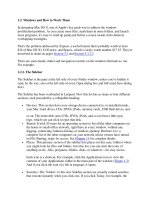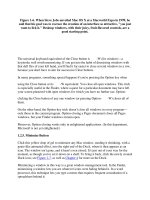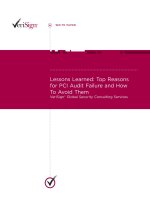ROCKS and how to identify them
Bạn đang xem bản rút gọn của tài liệu. Xem và tải ngay bản đầy đủ của tài liệu tại đây (4.17 MB, 52 trang )
ROCKS ... and how to identify them
A tutorial program offered to you by the Applied Science
Department of Glendale Community College
presented by:
Susan Celestian – Curator of the Arizona Mining and
Mineral Museum
Stan Celestian – Photographer and Instructor
© copyright 2006
This is your cue to advance to the next slide. (*)
THE ROCK CYCLE
Rocks are naturally occurring combinations or coherent
aggregates of minerals, fossils or other hard materials.
They are classified by the way in which they form. The
three rock types are: igneous, sedimentary and
metamorphic.
All rocks on Earth are locked into a system of cycling and
re-cycling known as the ROCK CYCLE. (*)
THE ROCK CYCLE
IG NE OU S
w
e
e
m
g
it n
l
s
e
h
s
e
r
u
a
t
li he
th
if rin
ic g
a ,
ti t
o ra
n n
s
,
e
r
p s
n
t, o
a i
m
e
lt
in
g
p
o
rt
a
ti
o
n
SE DIME NTAR Y
METAMORPHIC
weathering, transportation,
lithification
heat, pressure, ions
(*)
IGNEOUS ROCKS
vent
lava
la n d s u rfa
ce
conduit
magma
Anatomy of a Volcano
IGNEOUS ROCKS are “born of
fire”. In other words, they
were once molten and upon
cooling, the magma (molten
rock) crystallized into solid
rock. Igneous rocks may
form deep inside the Earth or
at the Earth’s surface when a
volcano erupts. (*)
IGNEOUS ROCKS
Rapid cooling near or at the
Earth’s surface, produces
Slow cooling deep beneath the
many small crystals that are
Earth’s surface allows crystals
not readily seen by the
to grow to large size (1/8” or
unaided eye. This group of
more). These crystals are
igneous rocks is called
easily visible and distinguish
EXTRUSIVE and are typically
volcanic in origin. Cooling
this group of igneous rocks as
may be so rapid that crystals
INTRUSIVE.
do not have a chance to form
and instead a glass is
produced. (*)
CLUES TO
IGNEOUS ROCKS
COLOR
TEXTURE
COARSEGRAINED
(You can see
different
minerals)
LIGHT COLORED
Felsic
GRANITE:
Can see crystals. Usually
gray
or pink. Can see
quartz - gray, glassy grains.
Can see feldspar - pink,
buff, or white.
INTERMEDIATE
COLORED
DIORITE:
PORPHYRITIC
(2 gra in s ize s )
FRAGMENTAL
OBS IDIAN:
PERLITE:
PUMICE:
VERY DARK
COLORED
Ultramafic
GABBRO:
PERIDOTITE:
BAS ALT:
AMPHIBOLITE:
Compos e d of 90Ca n s e e c r y s t a ls wi t h
Ca n s ee crys ta ls — lots of
somewhat
more light colored fla t s hiny cle a va ge s urfaces . 100% olivine
feldspar grains
than dark
colored minerals. A mix of light Us ua lly bla ck to gre e nis h
PYROXENITE:
and dark but with no quartz. Salt bla ck.
Compos e d of pre & pepper appearance.
do mina te ly pyroxe ne
FINERHYOLITE:
ANDESITE:
GRAINED
Us ua lly gra y, pink,
Light to da rk gra y.
(You ca n NOT pa s te l. Might s ee s ma ll s ma ll bla ck crys ta ls
cle a r, re cta ngula r crys ta ls .
s e e crys ta ls, for S ome time s ba nde d.
the mos t pa rt)
GLAS S Y
DARK COLORED
Mafic
Norma lly ha s
Us ua lly bla ck or rus t re d.
Compos e d of pre Ma y ha ve some or lots of
do mina te ly a mphibole s
ga s bubble ho le s , some
(s uch a s hornble nde )
hole s ma y be fille d. Ma y
s e e s ma ll gre e n gra ins .
Bla ck, re d, gre e n, GLAS S
Us ua lly pe a rly gra y. May contain Apa che Te a rs .
LOTS of ga s bubble ho le s , ve ry lightwe ight, will floa t on wa te r. Abra s ive.
ALL CRYSTALLINE IGNEOUS VARIETIES
ma y e xhibit porphyritic te xture
TUFF: Compa cte d volca nic fra gme nts ge ne ra lly le s s tha n 4mm dia me te r (a s h)
VOLCANIC BRECCIA: Mixe d tuff a nd a ngula r la rge (>32mm dia me te r) fra gme nts
AGGLOMERATE: Mixe d a s h a nd rounde d/s ub-rounde d la rge (>32mm dia me te r) fra gme nts
(*)
Granite - intrusive
quartz
biotite
mica
(*)
feldspar
(*)
GRANITE is a coarse to mediumgrained rock that forms from
the cooling of magma deep
within the Earth (intrusive). It
is made up mainly of varying
amounts of the minerals:
quartz, orthoclase, muscovite,
biotite and hornblende. The
name is from the Latin
granum, for “grains”.
Granite - intrusive
Graphic Granite
mica
Porphyritic
feldspar
Pegmatite
Granite - intrusive
tourmaline
feldspar
Pegmatite a Special Case
PEGMATITES are
classified as intrusive igneous
rocks, but there is a
difference. They are VERY
coarse grained and strictly
speaking are not crystallizing
out of a magma.
The coarse grained nature is
the result of crystal growth in
aqueous solutions rather than
in the molten liquid state.
mica
quartz
The resulting freedom of ion
motion allows the crystal to
grow much larger in a shorter
length of time. (*)
Diorite - intrusive
DIORITE is very similar to
granite, but is distinguished
in the hand specimen by the
absence of visible quartz.
Generally it has a salt and
pepper appearance (about
½ black and ½ white).
feldspar
biotite (*)
Gabbro - intrusive
GABBRO is a coarse-grained
rock that is high is iron &
magnesium-bearing minerals
(pyroxenes, amphiboles,
plagioclase feldspar, olivene).
The rocks will be dark in color,
somewhat heavier than
granitic rocks and devoid of
quartz.
Black minerals are primarily amphibole (like
hornblende) and plagioclase feldspar.
(*)
Peridotite - intrusive
PERIDOTITE or DUNITE is
composed of 90-100%
olivine. As a result it is
characteristically olive-greens
in color.
This material is thought to
have originated in the upper
mantle of the Earth. (*)
Rhyolite – extrusive
RHYOLITE’S
RHYOLITE name comes from
the Greek rhyo, from rhyax,
“stream of lava”. It is formed
when molten rock with the
same composition as a high
silica granite oozes (rhyolite is
VERY viscous and does not
really flow) to the Earth’s
surface; and therefore cools
quickly so only microscopic-
sized crystals develop. The
volcanoes that produce
rhyolite are very explosive
varieties such as Mt. St.
Helens, Krakatoa and
O’Leary Peak (AZ).
Frequently it is banded due
to flow alignment of different
associated minerals (quartz,
feldspar, mica, and
hornblende). (*)
Rhyolite – extrusive
This is another sample of rhyolite.
This has a crystal of garnet that
grew after the rhyolite was
This is an example of
deposited. (*)
banded rhyolite. (*)
If you look closely, you might see tiny clear phenocrysts of
feldspar. (*)
Andesite - extrusive
ANDESITE is the finegrained equivalent of
DIORITE. It tends to be
a darker gray than
rhyolite and is often
hornblende
porphyritic, with visible
phenocrysts (*)
hornblende.
Basalt - extrusive
BASALT occurs as thin to
massive lava. flows,
sometimes accumulating to
thicknesses of thousands of
feet and covering thousands
of square miles. The
volcanoes that produce
basaltic lavas are relatively
quiet, such as the Hawaiian
Islands volcanoes. Basalt
is dark, fine-grained and
often vesicular (having gas
pockets). The pockets may
be filled with secondary
minerals, e.g. quartz, zeolite
minerals, calcite, opal, etc.
and then it is called
amygdaloidal (a-mig-duh-loydal) basalt.
The name may have originated
with Pliny who used the
Ethiopian word basal for ironbearing rocks. (*)
Basalt - extrusive
Vesicular (Scoria)
Volcanic Bomb (*)
Gases released near the surface
of a lava flow create bubbles or
vesicles that are “frozen” in
stone. (*)
Amygdaloidal
(*)
Basalt - extrusive
Peridotite xenolith
Basalt (*)
Peridotite (*)
Basalt - extrusive
Pahoehoe is a feature
that forms on the
surface of very fluid
basalt flows. Much
like the skin on a bowl
of tomato soup – the
surface in contact with
the air begins to
crystallize, while the
fluid lava below
continues to flow. This
drags the upper, still
plastic, surface into a
series of smooth
wrinkles. (*)
Obsidian - extrusive
OBSIDIAN is volcanic glass (an
acrystalline “solid” –actually a
supercooled liquid). Its
glassy, lustrous and
sometimes banded
appearance makes it rather
easy to distinguish from all
other rocks. It is composed
of the elements that make
quartz, feldspar and iron/
magnesium minerals that
have cooled so quickly that
the minerals could not
develop and crystallize.
Colors vary from black to red,
black & red (mahogany),
gray, green, iridescent,
snowflake.
Apache Tears are little nodules
of obsidian.
Obsidian - extrusive
Flow banding
Snowflake
Apache tear
Perlite - extrusive
Apache Tear
PERLITE is a light gray volcanic
glass, having numerous
concentric cracks which give
rise to a perlitic or onion skin
structure. It is generally of
rhyolitic composition. It also
exhibits a pearly luster.
Apache Tears are some times
found embedded in perlite.
Pumice - extrusive
PUMICE is highly vesicular
(i.e. it has lots of gas
bubble holes) and is of
rhyolitic composition.
Due to the many small
holes, it is lightweight
and will often float in
water.
Tuff - extrusive
Tuff is the accumulation of ash
and small pyroclastic debris
(<4mm). Thick beds may
form for many miles around
a very explosive volcano,
such as Mt. St. Helens.
Often, when the material is still
hot upon deposition, it welds
into a very hard rock.
Volcanic Breccia - extrusive
VOLCANIC BRECCIA is
pyroclastic (fire-formed
fragments) and forms in
explosive eruptions. It is
a mix of large angular
fragments and small ash.
Often, the material is hot
when it comes to rest
and cools (welds) into a
very hard rock.









